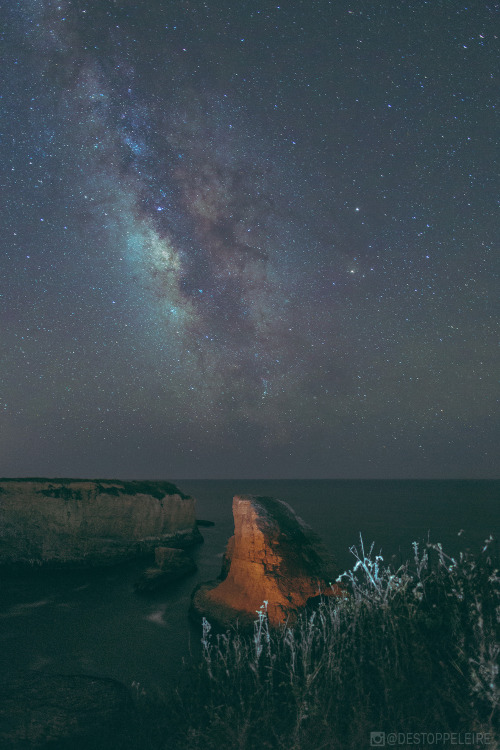The Galactic Core Over Sharkfin Cove, CA.

The Galactic Core over Sharkfin Cove, CA.
js
More Posts from Infinite--cosmos-blog and Others



Where the land, the sky, and the ocean meet.
Anastasia State Park, FL

Island Point Milky Way
Nikon d5100 - 6 x 25s - ISO 4000 - f2.8 - 16mm

Elephants Trunk Nebula IC1396
Thursday was the first clear night in ages so I took Friday off and stayed up most of the night imaging this beauty. Taken using a Canon 700D and a Canon 200mm lens

Amazing. Hubble’s Deep Field image in relation to the rest of the night sky.

Milky Way from Lake Cuyamaca js

What is so special about Saturn’s moon Titan?
Titan is Saturn’s largest moon and the only natural satellite in our solar system known to have a dense atmosphere. But there is something much more amazing about the Saturnian orbiter.
Titan has a vast system of oceans, lakes, and huge mountain ranges. How, though, could a body whose average temperature is -290°F (-179°C) contain liquid water on its surface? It doesn’t.
The oceans and lakes on Titan are made of liquid methane (CH₄) and ethane (C₂H₆). The mountains are made of water ice. That’s right. The “waters” of titan are made of not water, but hydrocarbons, and its mountain ranges are made of not minerals like calcium, iron, and cobalt, but ice.
Could, then, there be not water-based, but hydrocarbon-based life on Titan? Astrobiologists (scientists who study possible extraterrestrial life forms) are hoping to send rovers there one day to sample the oceans and answer that question.
If it turned out that there is life somewhere else in the solar system, it would be so much more than just a cool scientific discovery. For two hundred thousand years, we humans have thought that we were alone in the universe. We thought that only our blue and green home harbored life. If life turned up elsewhere, we would know that we were wrong all along.
(pictured: Titan; source: NASA, Cassini spacecraft, 2006)

White Ibis (Eudocimus albus) at Sunset
Lido Key Beach, FL

Three Bands of Light
The faint light extending up from the horizon just below centre of this photo is known as zodiacal light, caused by sunlight scattering from cosmic dust in the plane of our Earth’s orbit. A second band of light can be seen at the horizon on the lower left. This red light is airglow, produced by the Earth’s atmosphere. Airglow is caused by processes taking place in the upper atmosphere, including cosmic rays, recombining photoionized atoms, and various chemical reactions between oxygen, nitrogen, hydroxyl, sodium, and lithium atoms. The third and final band is the Milky Way, our home galaxy, high in the sky. This band consists of billions of stars of all kinds. Many of them are hidden to the human eye behind large layers of interstellar dust, giving the Milky Way its characteristically mottled look.
Credit: ESO/Y. Beletsky

“Look up at the stars and not down at your feet. Try to make sense of what you see, and wonder about what makes the universe exist. Be curious.” – Stephen Hawking
Stunning capture by Jordan McInally of @undersoulphotography

Afternoon Thunderstorms roll across the prairie.
Paynes Prairie Preserve State Park, FL
-
 sj-stars reblogged this · 4 years ago
sj-stars reblogged this · 4 years ago -
 starrgloww liked this · 5 years ago
starrgloww liked this · 5 years ago -
 igivewhatigot liked this · 5 years ago
igivewhatigot liked this · 5 years ago -
 yakutyanochka liked this · 5 years ago
yakutyanochka liked this · 5 years ago -
 keeyo7 reblogged this · 5 years ago
keeyo7 reblogged this · 5 years ago -
 spyderspic666 liked this · 5 years ago
spyderspic666 liked this · 5 years ago -
 stuffpilor liked this · 5 years ago
stuffpilor liked this · 5 years ago -
 strawberry-fly liked this · 6 years ago
strawberry-fly liked this · 6 years ago -
 jubilentj liked this · 6 years ago
jubilentj liked this · 6 years ago -
 thedreadpiratematt liked this · 6 years ago
thedreadpiratematt liked this · 6 years ago -
 htm-th liked this · 6 years ago
htm-th liked this · 6 years ago -
 prala liked this · 6 years ago
prala liked this · 6 years ago -
 goncstate93 reblogged this · 6 years ago
goncstate93 reblogged this · 6 years ago -
 goncstate93 liked this · 6 years ago
goncstate93 liked this · 6 years ago -
 thefuckword-deactivated1637 liked this · 6 years ago
thefuckword-deactivated1637 liked this · 6 years ago -
 dorkdoodles101 liked this · 6 years ago
dorkdoodles101 liked this · 6 years ago -
 astral-22 liked this · 6 years ago
astral-22 liked this · 6 years ago -
 roussi5 liked this · 6 years ago
roussi5 liked this · 6 years ago -
 thepurplepanda5 liked this · 6 years ago
thepurplepanda5 liked this · 6 years ago -
 smallfryingpan liked this · 6 years ago
smallfryingpan liked this · 6 years ago -
 durden44 reblogged this · 6 years ago
durden44 reblogged this · 6 years ago -
 a-doodling-demon liked this · 6 years ago
a-doodling-demon liked this · 6 years ago -
 nerdycashheroshepherd liked this · 6 years ago
nerdycashheroshepherd liked this · 6 years ago -
 sterlingsilverroses reblogged this · 6 years ago
sterlingsilverroses reblogged this · 6 years ago -
 sterlingsilverroses liked this · 6 years ago
sterlingsilverroses liked this · 6 years ago -
 hiraeth-mira liked this · 6 years ago
hiraeth-mira liked this · 6 years ago -
 xgeminixmoonx reblogged this · 6 years ago
xgeminixmoonx reblogged this · 6 years ago -
 xgeminixmoonx liked this · 6 years ago
xgeminixmoonx liked this · 6 years ago